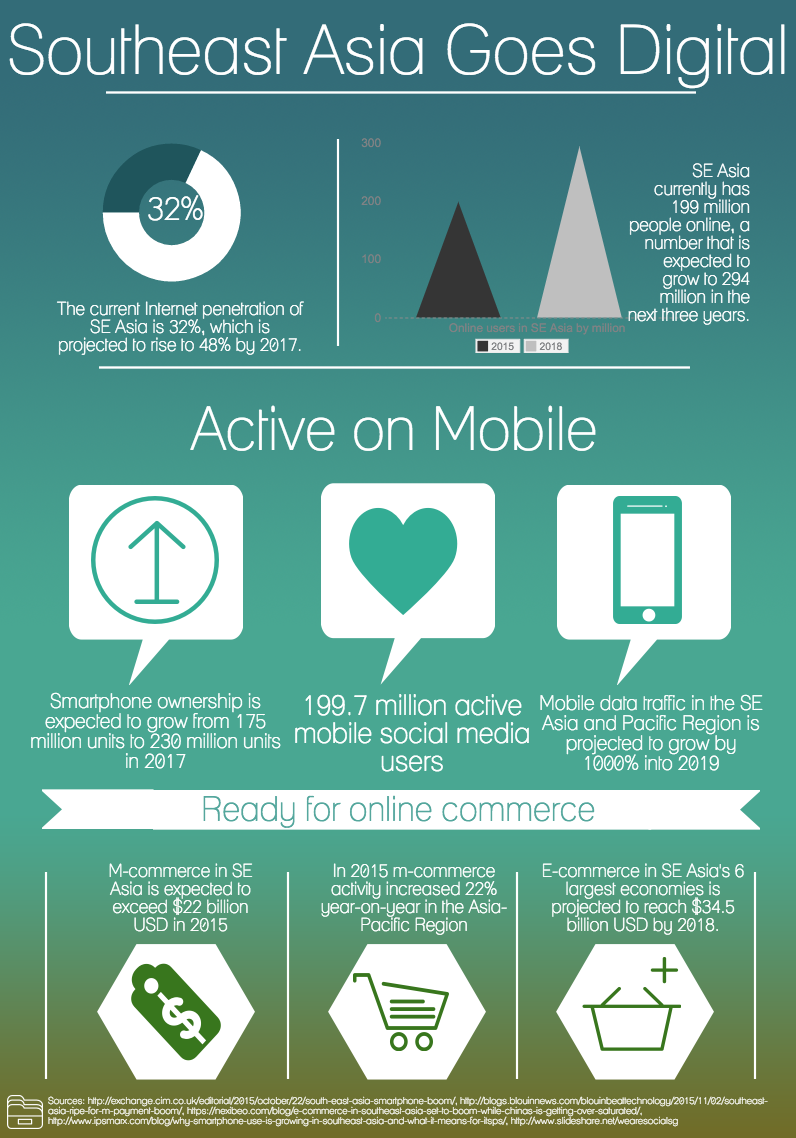When it comes to international digital marketing, there’s one country everyone is talking about: China. While China’s huge population and active online demographics are nothing to scoff at, it also represents a highly competitive market that is already filled with competing businesses trying to tap into it. With a booming e-commerce market, and more specifically m-commerce market, driven by social platforms such as WeChat, China is most definitely a key international online market. However, slowly but surely Southeast Asia is emerging as a comparable digital giant. With hundreds of millions of citizens going online, the potential of the Southeast Asian market needs to be on your brand’s to-watch list.
Low Internet Penetration, High Potential
While Southeast Asia has certainly made its way onto the radars of many digital marketers, it is also possible to overlook this region because of its relatively low internet penetration compared to other markets. The current estimated internet penetration in Southeast Asia is around 32%, a number that is projected to rise to 48% by 20171]. 32% may not sound particularly impressive, but We Are Social reported 252.4 million active internet users in Southeast Asia in November 2015 [2]. Even more impressive? Between March and November 2015 there were 27.4 million new active users, a 12% increase. Internet usage is picking up momentum in the region, which means huge potential for marketers looking to tap into new demographics.
It is also worth noting that Internet usage is generally higher in Southeast Asia’s 6 largest economies: Indonesia, Malaysia, Singapore, Thailand, Vietnam, and the Philippines. As of November 2015, the percentage of active internet users versus total population in these countries were:
● Indonesia: 34%
● Malaysia: 67%
● Singapore: 84%
● Thailand: 54%
● Vietnam: 50%
● Philippines: 46%
The low internet penetration in some areas of Southeast Asia is certainly a barrier for businesses looking to launch a digital marketing campaign, but it is also an opportunity to get into the market early while it continues to expand.
Mobile is Key
By far one of the most important factors driving internet usage in Southeast Asia is the rise of mobile devices. Much like China, Southeast Asia is a mobile-first region. For example, in Malaysia 35% of users only access the internet via their smartphone [1]. Mobile sales across the region are up; an estimated 175 million units were sold in 2015 and by 2017 that number could reach 230 million [3]. Not only that, but mobile data usage is increasing hand in hand with the proliferation of smartphone purchases. Mobile data traffic in the Southeast Asian and Oceania region is projected to grow 1000% by 2019. It’s worth reiterating: the potential of Southeast Asia is huge and should not be overlooked by any business looking to develop a comprehensive, international digital marketing strategy.

Mobile E-Commerce on the Rise
Perhaps unsurprisingly, the proliferation of mobile usage in Southeast Asia also correlates with the rise of e-commerce, particularly on mobile. The parallels with China continue here; just as m-commerce is a dominant force in China’s e-commerce market, the adoption of mobile in Southeast Asia is leading to a rise in mobile retail transactions. Though Southeast Asia is way behind China in terms of m-commerce, Visa’s 2015 Regional eCommerce Monitor Survey of the Asia-Pacific reported that m-commerce activity increased 22% year-on-year [3]. Much like the internet penetration, m-commerce usage has huge potential for growth. Currently, mobile commerce represents only 2% of retail sales in Southeast Asia’s 6 largest economies [4]. One challenge is that, unlike Alibaba in China, Southeast Asia lacks a unified, dominant online payment system. While this may be a current limitation, it is not difficult to imagine a future in which this hurdle is overcome and m-commerce in the region rapidly rises.
Even with the challenges, there is still a fruitful m-commerce market in Southeast Asia. 2013 saw $7 billion USD transactions, a number projected to rise to $34.5 billion in 2018 [3]. It is clear that m-commerce is picking up steam. In Mastercard’s 2014 Mobile Shopping Survey, 58.8% of respondents in Thailand had made a mobile purchase in the past few months. In Indonesia that number is 54.9%, in Malaysia 45.6%, and in Vietnam 45.2% [4].
Going Social
There are many implications for marketing to mobile-first regions, one of which is the importance of social media for the rapidly growing internet user base. Southeast Asia is no exception here. Remember those 252.4 million active internet users? Well, 232.9 million of them are active social media users. What’s more, 199.7 million of them are active mobile social media users [2]. Understanding the centrality of social media to the Southeast Asian internet experience is key because traditional digital marketing tactics are not going to be effective. Southeast Asia dove straight into Web 2.0 so banner ads and other forms of online advertising simply don’t resonate with this audience. Instead, brands need to focus their energy on developing an engaging social media presence that connects directly with users.
If you’re interested in developing a social media presence in Southeast Asia you’re likely wondering what platform(s) will bring the most success. Unlike China, which has developed its own mega platforms in response to the strict censorship of sites like Twitter, Facebook is the top social media network in most Southeast Asian countries [2]. However, just because the platform is one you’re used to working with, it doesn’t mean you should simply copy and paste your strategy for other markets here. Rather than adopting a cookie cutter approach, you need to be thinking about a nuanced, localized plan that will resonate with your specific target demographic. Having a strong cultural marketing strategy on social media is particularly important for regions like Southeast Asia that are jumping onto these platforms and ignoring the more traditional Web 1.0 and 1.5 that North America is still connected to.
From its rising internet usage to mobile-first mindset, it appears that Southeast Asia is poised to become the next key international digital market. Businesses looking to expand their international presence should certainly keep an eye on further developments.



![Connect with South Asian Canadians With These English [And Hindi!] Diwali Wishes](https://www.latmultilingual.com/wp-content/uploads/2023/11/Diwali-500x383.png)









